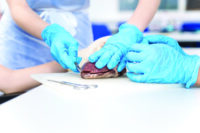Innovation is tough in any classroom. However, that’s no reason not to do it! Because high school curricula are typically content-driven, students don’t often have the opportunity to practice learning in novel situations.
Many teachers using guided inquiry activities (guided inquiry is a teaching technique, unlike true inquiry where the students direct the learning) have the same frustrations. Let’s look at some common student complaints and how to overcome them.
Just tell us what to do.
In my experience, most students do not come to school to think; they come to be told what to do. Designing lab experiences that get students to start thinking on their own helps this process. Start the year with traditional lab procedures, giving every step, then remove steps as the year progresses. As you do so, point out these missing steps verbally during a pre-lab overview. If you use the same equipment and procedures throughout the year, eventually they won’t need reminders.
- Flip this portion of instruction. Record yourself setting up the equipment or going through your pre-lab overview. Have students watch the video before coming to class; class time is then spent performing the lab and analyzing results. If students forget to watch the video, they should stay at their desks to watch the video while the other groups begin the lab. There will still be enough time for everyone to perform the lab, but those who forgot to watch the video in advance will analyze their results for homework.
What should I have gotten?
Some students are terrified of making mistakes in a lab activity. My response is always “It doesn’t matter what you got, as long as you can explain how you got it.” At the beginning of the year, give them the data table for their information, but in later labs, have them make their own. Have them document their learning with pictures throughout the lab so you can see what they see.
- Don’t be afraid to crowdsource learning! Create a Google slide file, and share it with the entire class. Design a simple slide to show them what you want (results, error, picture of their results, etc.), then have them copy the single slide and insert their own information. Then you’ll have one file that contains the results from everyone in the class! It also allows them to learn from each other because they can see everyone’s work.
We’re always doing inquiry labs.
Guided inquiry labs take more time than traditional labs in every way—creating, setting up, performing, and analyzing—so too many can be taxing on both students and teachers. Spread the guided inquiry labs out over the year. In your first year, have only 1 per marking period or 1 per semester. Once you see how they go, consider adding 1 per unit, or immediately follow an inquiry lab with a traditional lab.
- You can also use traditional procedures but include non-traditional analysis. Have students create a short video, collage, or 3-slide presentation to demonstrate their learning.
That group got something different. Did I do something wrong?
I give everyone the same materials and equipment but let them choose their own amounts to use. While everyone generally has the same chemical change, for example, the change happens in varying degrees. One group might create 12 grams of product while another creates 1 gram.
Focus on asking students quality questions about what they learned. Ask them to walk you through their procedures and explain how they got to their product. This will allow you to see what they learned and help them articulate possible sources of error, if any exists. Don’t be afraid to give loose guidelines and let students meander their way to the outcome.
- When students are explaining their results, don’t be afraid to record them on video using your cell phone. These videos can easily be uploaded to YouTube and shared with parents, administrators, or next year’s students so they can compare their results.
We haven’t learned anything yet. How can we do a lab?
Many guided inquiry labs come at the beginning of a unit. Students may not understand the chemistry behind the lab, but they’re learning it through the activity. Redesign your analysis questions to walk students through the calculations and the learning. When they get to a certain point in the activity, have them watch a short instructional video in which you explain the concepts behind the lab.
Any non-traditional teaching method requires time and energy, both to implement for the first time and to modify for the next year. Some will be wildly successful, and others . . . well . . . less so. No matter what you’re doing, focus on the learning—not the content—and on making the time in class meaningful for everyone.
Marc Seigel
Chemistry Teacher
Middletown High School
South Middletown, NJ




